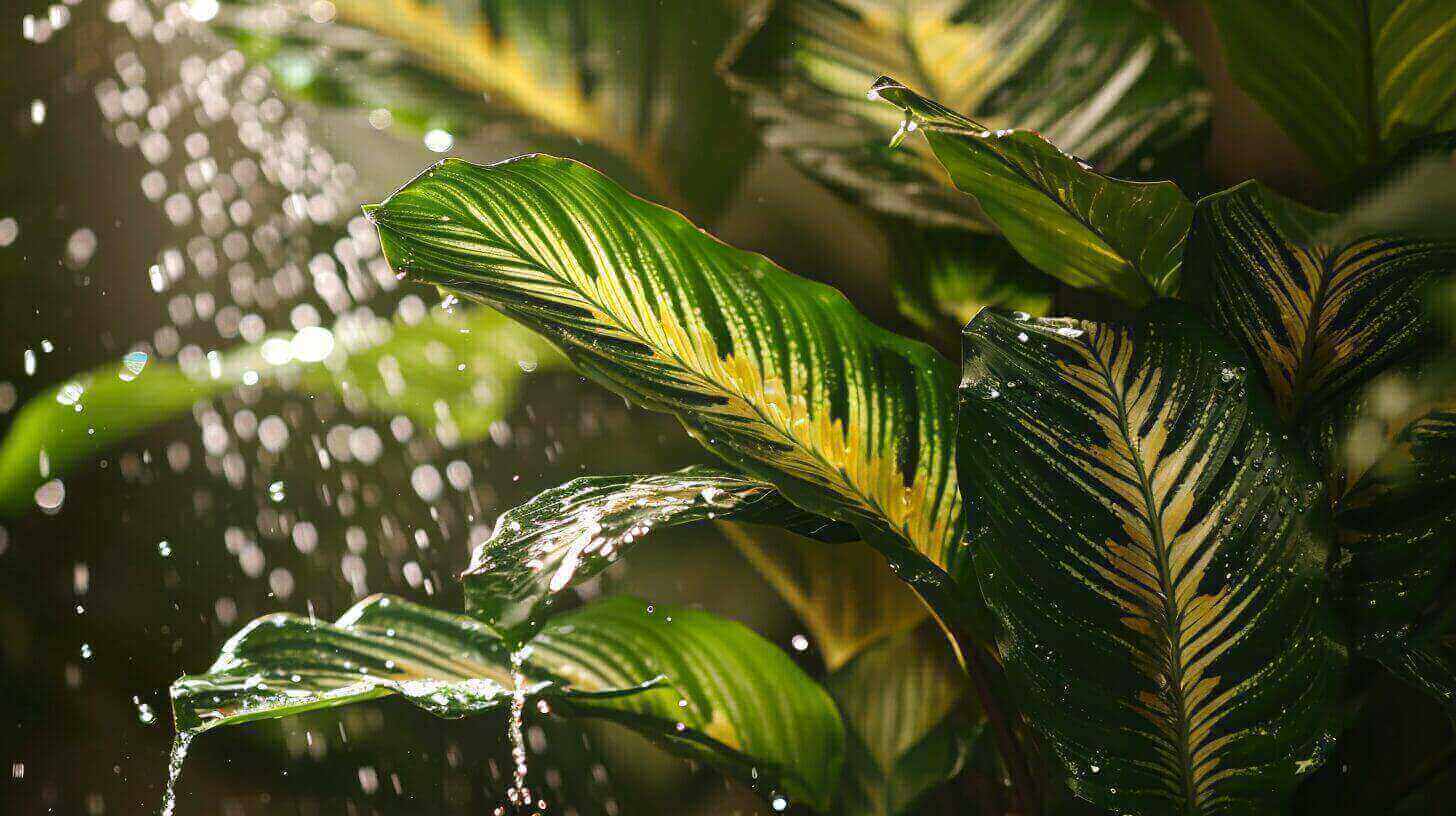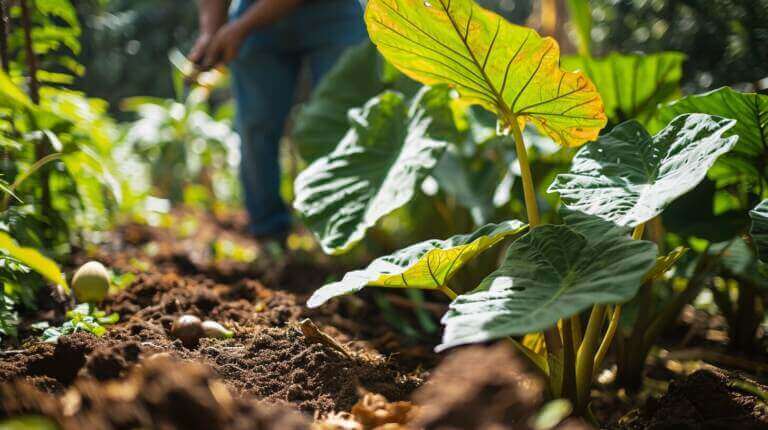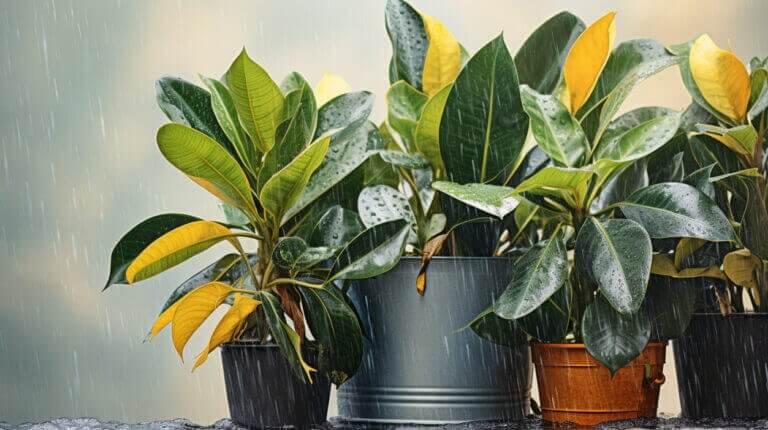Best Watering Calathea Plant Care Guide: Water Amount, Frequency and Best Practices
Calatheas houseplant, also known as prayer plants, are tropical indoor plants that require proper watering to thrive. They prefer soil that is consistently evenly moist but not soggy. It is recommended to check the moisture level in the soil before watering and to water the plant when the top 2 inches of soil are dry. Overwatering can lead to root rot, while underwatering can cause browning, yellowing, or curling leaves. Calatheas benefit from bottom watering or using self-watering planters. Adequate humidity is also important, and misting or using a humidifier can help maintain the moisture level. The placement of Calatheas in a bright indirect light is ideal, avoiding direct sunlight that can scorch the leaves. It is important to rotate the plant regularly for even growth and regularly dust the leaves to maintain efficient photosynthesis.
Key Takeaways:
- Calatheas prefer consistently even moisture in the soil but not soggy conditions.
- Water when the top 2 inches of soil are dry to avoid overwatering or underwatering.
- Bottom watering or using self-watering planters can help ensure adequate watering.
- Maintain proper humidity levels through misting or using a humidifier.
- Place Calatheas in bright indirect light and rotate regularly for even growth.
Calathea Care: Placement and Lighting Requirements
Proper placement and lighting are essential for the health and growth of Calathea plants. These tropical indoor plants thrive when placed in an area with bright indirect light. Direct sunlight should be avoided as it can damage the delicate leaves. Calatheas have the fascinating ability to change the spread and angle of their leaves throughout the day to maximize sun absorbency, making them well-suited for bright but indirect light conditions.
A temperature range between 70 and 85 degrees Fahrenheit is ideal for Calatheas. It’s important to keep them away from hot and cold drafts, such as window breezes, heaters, and air conditioning, as these can negatively impact the plant’s overall well-being.
To achieve optimal growth, supplemental humidity is beneficial for Calatheas. They prefer humidity levels between 50 and 70 percent. Misting the leaves or using a humidifier can help maintain the humidity level required for their health.
Key Points:
- Place Calathea plants in an area with bright indirect light to avoid leaf damage.
- Maintain a temperature range of 70-85 degrees Fahrenheit for optimal growth.
- Keep Calatheas away from hot and cold drafts to prevent stress.
- Provide supplemental humidity with misting or a humidifier to promote healthy growth.
Considering the placement and lighting requirements of Calatheas ensures that these stunning indoor plants thrive in your home or office space. By providing the right conditions, you can enjoy the beauty of their vibrant foliage and create a welcoming and relaxing environment.
| Placement Requirements | Lighting Requirements |
|---|---|
| Bright indirect light | Avoid direct sunlight |
| Away from hot and cold drafts | Temperature range of 70-85°F |
| Supplemental humidity | Mist leaves or use a humidifier |
Watering Calathea Plants: Frequency and Amount
Proper watering is crucial for the health and vitality of Calathea plants. To determine the frequency of watering, it is essential to consider various factors such as the growing environment, plant size, pot size, and individual characteristics. As a general guideline, it is recommended to water your Calathea when the top 2 inches of soil are dry. This allows for adequate moisture without risking overwatering, which can lead to root rot. Underwatering should also be avoided, as it can cause browning and curling of the leaves.
When it comes to the amount of water, it is best to use filtered or distilled water rather than tap water. Tap water may contain minerals and compounds that can be harmful to the leaves of your Calathea. Using filtered or distilled water helps ensure that the plant receives clean and healthy hydration.
Bottom watering or using self-watering planters can be beneficial for Calathea plants. These methods allow the roots to draw water as needed while keeping the top layer of soil to dry. Monitoring the soil moisture level with a soil probe can also help determine the watering needs of your Calathea. By maintaining appropriate moisture levels, you can promote healthy growth and prevent issues caused by over or under watering.
Table: Watering Guidelines for Calathea Plants
| Plant Size | Pot Size | Watering Frequency |
|---|---|---|
| Small | 4-inch pot | Once every 5-7 days |
| Medium | 6-inch pot | Once every 7-10 days |
| Large | 8-inch pot | Once every 10-14 days |
By understanding the watering needs of your Calathea plants and following proper watering practices, you can provide optimal care and create an environment that promotes their overall well-being. Remember to consider the specific conditions of your growing environment and adjust watering frequency and amount accordingly. Monitoring the soil moisture level and using filtered or distilled water will help keep your Calathea plants healthy and thriving.
Soil and Potting Requirements for Calatheas
When it comes to the soil and potting requirements for Calatheas, it’s important to create a balanced environment that promotes their overall health and growth. Calatheas thrive in soil that is consistently evenly moist but well-draining. This means finding the right potting mix that allows for adequate moisture retention while also providing proper drainage.
An ideal potting mix for Calatheas consists of a combination of coarse materials like perlite or gravel, which help with drainage, and organic soil material that retains moisture. It’s best to avoid potting soils that contain water-retentive crystals, as they can lead to overly moist soil and increase the risk of root rot.
Additionally, it’s crucial to choose pots with drainage holes to prevent water from accumulating at the bottom. This helps prevent waterlogged soil, which can be detrimental to the roots of Calatheas. The size of the pot is also important, as it should be suitable for the plant’s size and allow for healthy root development. Repotting should be done every 12-18 months, using a pot that is 1-2 inches larger in diameter to accommodate the growing plant.
The Importance of Soil and Potting Requirements
Creating the right soil and potting environment for Calatheas is essential for their overall well-being. A suitable potting mix with good drainage and moisture retention helps prevent overwatering, which can lead to root rot and other issues. The presence of drainage holes in pots allows excess water to escape, reducing the risk of waterlogged soil. Adequate root development is crucial for the plant’s growth, which is why repotting in a larger pot when needed is necessary.
Summary Table: Soil and Potting Requirements
| Requirement | Details |
|---|---|
| Potting Mix | Consists of coarse materials for drainage and organic soil material for moisture retention |
| Avoid Water-retentive Crystals | These can lead to overly moist soil and increase the risk of root rot |
| Pot Type | Choose pots with drainage holes to prevent water accumulation and waterlogged soil |
| Pot Size | Select pots that are suitable for the plant’s size and allow for healthy root development |
| Repotting Frequency | Repot every 12-18 months using a larger pot |
Factors Affecting Calathea Watering Needs
When it comes to watering Calathea plants, several factors come into play. Understanding these factors is crucial in determining the appropriate watering schedule for these tropical indoor plants. Temperature and humidity levels play a significant role in the watering needs of Calatheas. These plants prefer temperatures between 70 and 85 degrees Fahrenheit and humidity levels between 50 and 70 percent. So, it’s important to consider these environmental conditions when watering your Calatheas.
Another factor to consider is the plant’s growth period. Calatheas go through phases of active growth and slower growth. During periods of active growth, they may require more frequent watering to support their increased metabolic activity. On the other hand, during slower growth periods, they may need less water. It’s essential to monitor the growth stage of your Calathea plants to adjust the watering frequency accordingly.
The size of the pot and the age of the plant are also factors that affect watering needs. Larger pots generally hold more moisture, requiring less frequent watering. Younger plants may have smaller root systems and therefore need less water compared to more established ones. By considering the pot size and the age of your Calathea, you can ensure you’re providing the right amount of water for optimal growth.
By taking these factors into account and regularly monitoring the environmental conditions and the overall health of your Calathea plants, you can determine the appropriate watering schedule. Remember, maintaining the right temperature, humidity, pot size, and adjusting watering based on the growth period of the plant are key to keeping your Calatheas healthy and thriving.
FAQ
How do I know if my Calathea plant needs water?
You can check the moisture level in the soil by feeling the top 2 inches. If it’s dry, it’s time to water.
Should I use tap water or filtered water to water my Calathea plant?
It is recommended to use filtered or distilled water to avoid potential harm from minerals and compounds in tap water.
How does humidity affect the care of Calathea plants?
Calatheas are tropical plants and they thrive in high humidity environments. You can increase the humidity around your plant by placing it on a tray of pebbles filled with water or using a humidifier.
How often should you water your Calathea?
The watering routine for a Calathea plant depends on its environment. Generally, you should keep the soil moist but not soggy. Adjust your watering schedule based on the season and the plant’s needs.
What are some common issues with Calathea houseplants?
Spider mites can be a common issue. They can be prevented by maintaining high humidity and regularly checking the foliage of your plant.
How often should I fertilize my Calathea?
During the growing season (spring and summer), you should fertilize your Calathea every month. Use a balanced, water-soluble fertilizer and always follow the package instructions.
What type of potting mix is best for Calathea?
A well-draining potting mix is essential for Calathea. It should retain some moisture but not allow the roots to sit in standing water to prevent root rot.
How do I care for the foliage of my Calathea?
Keep your plant in a location where it receives the right amount of light – not too bright, but not too dark. Wipe the leaves with a damp cloth occasionally to keep them clean and healthy.
How much water does a Calathea need?
The amount of water a Calathea needs can depend on its size, the pot size, and the environment. A good rule of thumb is to water when the top inch of soil feels dry to the touch.
What are the signs of an underwatered Calathea?
Signs of an underwatered Calathea include wilting or browning leaves. If your Calathea shows these signs, adjust your watering routine to ensure your plant gets the right amount of water.







